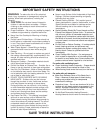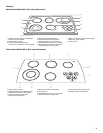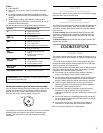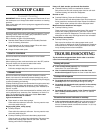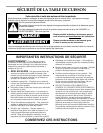
9
Keep Warm Function
(on Electronic Touch Control models)
The Keep Warm Function can be used to keep cooked foods
warm, and may be used whether or not the other surface cooking
zones are in use.
It is not recommended for heating cold foods. When the Keep
Warm Function is in use, it will not glow red like the cooking
zones, but the indicator light will glow on the control panel.
Use only cookware and dishes recommended for oven and
cooktop use, and that have flat bottoms to make direct contact
with the cooktop surface. Use pot holders or oven mitts to
remove cookware.
Cover all foods with a lid or aluminum foil. Do not use plastic
wrap to cover food, as it may melt onto the cooktop surface.
When warming baked goods, allow a small opening in the cover
for moisture to escape.
Food quality may deteriorate if food is kept on the Keep Warm
Function for an extended period. For best results, keep food
warm for no longer than 30 to 45 minutes.
On models with touch controls, the Keep Warm element is
available on all surface cooking areas, and can be used as either
an element for warming foods, or for normal element operation.
To Use:
1.
Touch ON/OFF.
2.
Touch the “up” arrow twice for KEEP WARM.
3.
When finished cooking, touch ON/OFF to turn surface
cooking area off.
Home Canning
When canning for long periods, alternate the use of surface
cooking areas, elements or surface burners between batches.
This allows time for the most recently used areas to cool.
■
Center the canner on the grate or largest surface cooking
area or element. Canners should not extend more than 1 in.
(2.5 cm) outside the cooking area.
■
Do not place canner on two surface cooking areas, elements
or surface burners at the same time.
■
Use only flat-bottomed canners.
■
For more information, contact your local U.S. Government
Agricultural Department Extension Office. In Canada, contact
Agriculture Canada. Companies that manufacture home
canning products can also offer assistance.
Cookware
IMPORTANT:
Never leave empty cookware on a hot surface
cooking area, element or surface burner.
Ideal cookware should have a flat bottom, straight sides, a well-
fitting lid and the material should be of medium-to-heavy
thickness.
Rough finishes may scratch the cooktop. Aluminum and copper
may be used as a core or base in cookware. However, when used
as a base it can leave permanent marks on the cooktop or grates.
Cookware material is a factor in how quickly and evenly heat is
transferred, which affects cooking results. A nonstick finish has
the same characteristics as its base material. For example,
aluminum cookware with a nonstick finish will take on the
properties of aluminum.
Use the following chart as a guide for cookware material
characteristics.
WARNING
Food Poisoning Hazard
Do not let food sit for more than one hour before
or after cooking.
Doing so can result in food poisoning or
sickness.
COOKWARE CHARACTERISTICS
Aluminum
■
Heats quickly and evenly.
■
Suitable for all types of cooking.
■
Medium or heavy thickness is best for
most cooking tasks.
Cast iron
■
Heats slowly and evenly.
■
Good for browning and frying.
■
Maintains heat for slow cooking.
Ceramic or
Ceramic glass
■
Follow manufacturer’s instructions.
■
Heats slowly, but unevenly.
■
Ideal results on low to medium heat
settings.
Copper
■
Heats very quickly and evenly.
Earthenware
■
Follow manufacturer’s instructions.
■
Use on low heat settings.
Porcelain enamel-
on-steel or cast
iron
■
See stainless steel or cast iron.
Stainless steel
■
Heats quickly, but unevenly.
■
A core or base of aluminum or copper on
stainless steel provides even heating.





